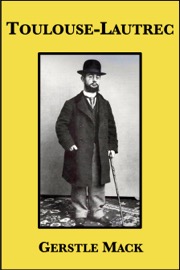 $9.99 on Kindle
$9.99 on KindleToulouse-Lautrec by Gerstle Mack (113,000 words, 59 illustrations)
The first complete biography in English of the painter Henri de Toulouse-Lautrec (1864-1901), whose short but intensely active life is portrayed against a colorful “gay nineties” background of dance-halls, brothels, cafés-concerts, theaters, circuses, and racecourses. A descendant of one of the noblest families in France, grotesquely deformed, hideously ugly, Lautrec voluntarily renounced the life of a country gentleman for the tawdry environment of Montmartre, where dissipation wrecked his health and brought about his premature death at the age of thirty-seven. Strangely enough, drink and debauchery had little apparent effect on his work; he remained to the end a great artist: a sensitive painter, a superb draughtsman and lithographer, and an unrivaled designer of pictorial posters.
“Gerstle Mack’s book, so complete, so searching, so just, adds to his already high prestige as a biographer and, once more (as with respect to the previous book on Cézanne) puts the art world in his debt. The Toulouse-Lautrec biography is informed throughout, with a spirit of warm human understanding and of fine critical integrity.” — Edward Alden Jewell, The New York Times (November 6, 1938)
“[A] distinguished and authoritative biography... a definitive work..." — Charles Poore, The New York Times (October 15, 1938)
“First-rate biography of the dwarf genius who was one of the best draftsmen of his or any age. Lautrec’s circus-and-brothel background is neatly worked in and the book is full of understanding and sympathy.” — The New Yorker
“A distinguished book” — The Atlantic
“Mr. Mack’s biography [is] complete, unmitigated, authoritative... a thorough documentation not only of the works but of the milieu of Toulouse-Lautrec.” — The Nation
“This is a thoroughly sound and entertaining piece of work.” — Saturday Review
“Various biographers have chronicled the brief and meteoric career of Lautrec but none has done it with the thoroughness and dispassionate scholarship, the sensitivity and sympathy, as has Gerstle Mack. The personality of the man rather than his analysis as an artist is Mack’s motivating purpose and he has patiently tracked Lautrec through all the haunts he loved and introduced all of the period’s personalities who were habitués of Lautrec’s world. Mr. Mack has also demolished the popular theory that Lautrec loathed his models and really was a-crusader against the vice he portrayed. Lautrec was a powerful critic of the time and place but always presented the scene with a sympathetic, if trenchant, wit. He provided a profound insight into the times. He displayed the tawdriness disguised as glamour and the boredom disguised as excitement. He created a wonderful and powerful style that has influenced generations of artists, particularly in the graphic arts.” — Irvin Haas, Book Find News
“Gerstle Mack has written a book of remarkable interest not only from the point of view of the artist but from the point of view of the variety of human personality. This desperate and talented man shoved his way into the late nineteenth century life of Paris. This book will shove its way into the midtwentieth century life of that western world which is still free to contemplate the essential violence and harmony of art.” — Paul Engle, Chicago Tribune
“This first complete English biography is an admirable portrait of Lautrec and his times. Based upon thorough research and first-hand interviews, it makes absorbing reading... We are not told specifically how the simple, eager boy became the strange and contradictory man. Nevertheless, in these days of biographies filled with the speculations of amateur psychiatrists, it is both refreshing and good to re-encounter this sound and unpretentious study.” — Art Digest
“An artist’s biography, good reading, with a well-filled background of Montmartre cafés and their owners and entertainers, the theatre, the circus, whorehouses and so on. The man himself is interesting. The sources of his artistic material equally so. He loved sports and his eccentric father wanted him to attain physical perfection, but he was handicapped in his teens by having his legs badly broken. So he turned to art, studying, worshipping Degas and Japanese prints, seeking Paris night life for his subjects, and producing illustrations and poster designs that equalled the fame of his lithographs. An art book as well as excellent biography.” — Kirkus Reviews



